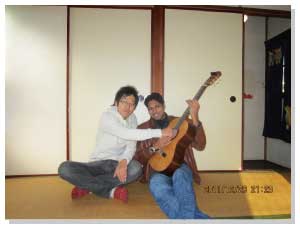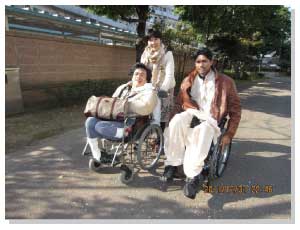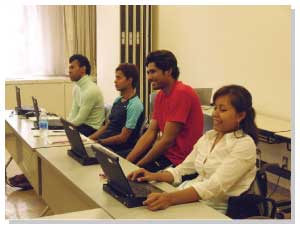- HOME
- Alumni News
- Rizwan Ijaz (13th trainee)
- Rizwan's Final Report
Rizwan's Final Report
Toward a Discrimination-Free Society
1. Introduction
I became disabled when I was four months old. When I was a child I wanted to play with my friends in my neighborhood, but my parents would not allow me. Life at that time was extremely boring. I entered a school for disabled children and made new friends. Even though I enjoyed myself while being with my friends at school, life was still boring at home. I was a member of the boy-scout team and traveled to another town with my school teacher and classmates. This was the first time for me to be away from home. It was a great experience. After two years at university, I joined the Milestone, where I met many other people with disabilities for the first time. At the Milestone I was involved in the planning and organization of cricket and marathon events as a sport coordinator. In 2011, I was selected as one of the trainees for the Duskin leadership program and flew over to Japan. I was worried whether I could communicate well with others, but the staff of the Japanese Society for Rehabilitation of Persons with Disabilities (hereafter JSRPD) gave me a warm welcome at the Kansai Airport. I also met other trainees from six different countries. They were all polite and soon we became friends.

2. Japanese language
After I was selected for the leadership training, I received some beginner-level learning materials for Japanese which were sent by JSRPD. I tried to learn Japanese with the materials but it seemed extremely difficult. The Japanese classes started after we arrived in Japan. I was still very worried. But the teachers were very experienced and used methods that were easy for us to understand. For example, the games used in class were not only fun, but also helped improve our Japanese. Gradually, I was able to speak Japanese with my fellow trainees and the JSRPD staff. During the three months of Japanese language classes, I also enjoyed many activities like going for a walk with my fellow trainees and going out with my friends at weekends.
3. Home-Stay
I experienced the home-stay programs at two Japanese homes. I stayed with Mr. Kuwabara in Tokyo for only one night, which was enough time for us to become good friends. After that, I traveled to Fukuoka and stayed with the Toshimitsu family for approximately one week. Through the home-stay experience I got to learn about the Japanese life and tradition, and I also greatly enjoyed lovely Japanese meals. With the kind Toshimitsu family, I enjoyed the town with ample nature and also met their friends. As they cooked me Japanese meals, I reciprocated by cooking them Pakistani food. It is such a lovely memory.


4. Skiing
I experienced skiing for the first time in my life. In the beginning I was worried about falling over. But my ski teacher and Ms. Okuhira advised me to relax and just enjoy it, so I was able to enjoy myself. I will never forget the two days of skiing for the rest of my life.

5. Individual training
(1) Japan Council on Independent Living Center (JIL)
Individual training started after the home-stay program. My first training destination was JIL. There I learned about administration, independent living movement, disability movement, and networking among young people with disabilities. I talked with Mr. Nakanishi about disability movement, personal assistant services and networking. Mr. Nakanishi was very kind and shared his own experiences with me, and showed me directions as to how to become a leader of disability movement in Pakistan.
(2) Non Profit Organization Center for Independent Living “Iruka Okinawa”
With my Japanese still not so good, I was worried about leaving Tokyo for Okinawa by myself. In Okinawa, I got busy every day. I visited the prefectural government, participated in seminars, visited facilities, and learned why it was important to live independently.
(3) Mainstream Association
At the Mainstream Association, I studied about people with disabilities, centers for independent living, personal assistant services and disability movement. I also learned about discrimination against people with disabilities, how to overcome discrimination, and how to support people with disabilities living independently in their community. At the Mainstream, everyone had a clear purpose, enjoyed their job and was responsible for their individual role. No matter how severe their disability might be, they were working hard and also enjoying their life. The experience at Mainstream Association gave me many unforgettable moments and also a lot of confidence in me.
(4) Japan National Assembly of Disabled People’s International (DPI-Japan)
At the DPI, I learned about their operation and Japanese welfare system for people with disabilities. I had many discussions with everyone at DPI. They gave me a lot of information, including those related to DPI’s activities.
(5) Sakura Project
The Sakura Project is engaged in collecting electric and manual wheelchairs that are no longer in use They repair send them to Pakistan, where the wheelchairs are distributed primarily to people with severe disabilities.

6. Toward a discrimination-free society
(1) The life of people with disabilities in Pakistan
There is so much discrimination in Pakistan towards people with disabilities. It is not a barrier-free society, and it does not have any welfare system as Japan does. For example, there is no personal assistant service system, so people with disabilities have to rely on their friends and families. As such, there are many obstacles in the life of people with disabilities in Pakistan.
(2) The life of people with disabilities in Japan
The life of people with disabilities in Japan is very different and extremely convenient. The towns are planned barrier-free, and there are many wonderful systems such as personal assistant dispatch service. People with disabilities in Japan think for themselves, decide for themselves and take responsibility for their life. How did such wonderful systems develop? In Japan, a group of people with cerebral palsy started disability movement in 1950s. The first center of independent living in Japan, the Human Care Association, was established in 1986. People with disabilities got together to hold seminars, work on advocacy movement, and marched in demonstrations. These activities blossomed and made Japan what it is now. These people faced so many difficulties, and it took a long time to tackle them, but people with disabilities in Japan did it.
(3) My work after returning to Pakistan
Japan and Pakistan have different lifestyles and cultures. However, the common thread is that people with disabilities face discriminations and difficulties. It is of utmost importance to create a society wherein quality of life is secured and maintained for people with disabilities. In order to do this, I will engage in the following activities.
- Disability movement
- Develop a movement towards accessible public transports and an accessible society
- Install welfare policies including personal assistant services
- Advocacy
- Create a good image of people with disabilities within the society of Pakistan.
- Networking
- Network with other disability people’s organizations and work together.
- Sports
- Introduce sports for people with disabilities in Pakistan, such as basketball and tennis.
7. Words of gratitude
Thank you so much to everyone at the Duskin AINOWA Foundation, the Japanese Society for Rehabilitation of Persons with Disabilities, and everyone I met at my training destinations.




